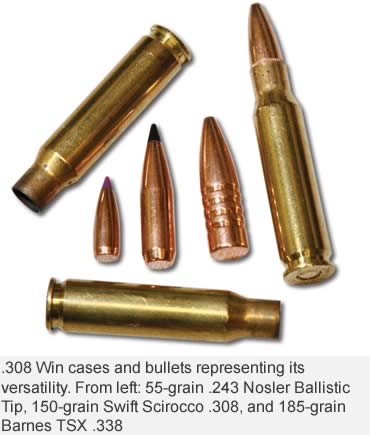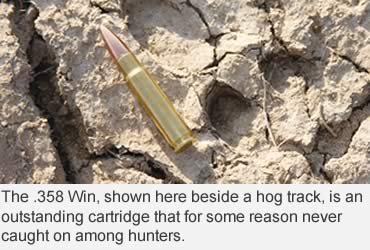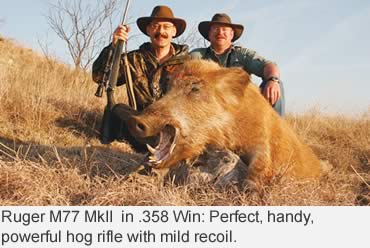Offspring of the .308 are accurate, compact and easy to shoot.
Rifle cartridges may be inanimate, but they do have families. One of the more prolific is the .308 Winchester family, a well-rounded line of nicely balanced cartridges that are fast, powerful, easy to shoot and justifiably popular.
The clan currently consists of the .243 Winchester, .260 Remington, 7mm-08 Remington, .308 Winchester and .358 Winchester with a few semi-legitimate siblings waiting in the wings.
The group started with Winchester’s 1952 release of its self-named .308. The cartridge was under development as a military round to replace the longer .30-06 Springfield. Knowing how quickly and widely U.S. military rounds were adopted by the hunting public, Winchester wisely released the commercial version of the round two years before the military accepted it. It became known as the 7.62x51mm NATO in military parlance. Service rifles weren’t chambered for it until 1957.
Essentially, the .308 Win is a shortened version of the .30-06 Springfield. Both have a 0.473-inch head diameter and a .470-inch body with minimum taper. The .308’s shoulder is a bit sharper at 20 degrees.
 The big difference is case length, with the .308 being 0.479 inch or nearly a half inch shorter. The resultant reduction in powder capacity leaves the .308 pushing same-size bullets 100 to 200 fps slower.
The big difference is case length, with the .308 being 0.479 inch or nearly a half inch shorter. The resultant reduction in powder capacity leaves the .308 pushing same-size bullets 100 to 200 fps slower.
While it can handle 180-grain projectiles, 150-grain bullets are optimal.
Handloaders can choose from 100-grain plinkers to 220-grain monsters. Factory cartridges are usually limited to 125- to 180-grain loads.
The benefits accruing from the .308 are compactness and milder recoil, and these carry throughout the family. Short-action rifles can be built slightly smaller and lighter than standard actions. Arguably they cycle slightly faster, but this is of questionable value.
In my opinion, the .308’s real value is its ability to nearly match .30-06 speeds with the same bullets at less weight and recoil. The round is wonderfully accurate, has won thousands of short- and long-range target matches, is used by military snipers to 1,000 yards and has brought down virtually every big game species on the planet.
The potential of the new .308 Win case wasn’t lost on America’s wildcatters, those rifle nuts who always think they can create something better than the factories. The easiest way to do that is by changing the neck diameter of the parent case. Just which diameter was first squeezed or flared into the .308 Win remains a mystery, but by 1955, Winchester introduced the .243 Winchester.
 Field and Stream shooting editor Warren Page is credited with first creating it as the .240 Page Pooper shortly after the .308 brass hit the streets. The .243 Win is now the world’s most popular .243 caliber. With 55- to 90-grain bullets, it is hell on varmints and coyotes. With well-built 80- to 100-grain bullets, it’s deadly on deer, pronghorns and even hogs and black bears. Recoil is so mild that nearly anyone can shoot it without flinching.
Field and Stream shooting editor Warren Page is credited with first creating it as the .240 Page Pooper shortly after the .308 brass hit the streets. The .243 Win is now the world’s most popular .243 caliber. With 55- to 90-grain bullets, it is hell on varmints and coyotes. With well-built 80- to 100-grain bullets, it’s deadly on deer, pronghorns and even hogs and black bears. Recoil is so mild that nearly anyone can shoot it without flinching.
The next most popular in this exalted family is the 7mm-08 Remington. A successful wildcat for years, the round wasn’t officially released by Remington until 1980. It is to the .280 Remington what the .308 is to the .30-06.
Many consider the 7mm-08, which consists of a .284 bullet atop the .308 Win case, the ultimate deer rifle. Its bullets from 120 to 150 grains are fast, wide and heavy enough to handle any deer, yet recoil is even less than the .308 Win. As a bonus, the 7mm-08 shoots slightly flatter. With 160- to 175-grain bullets, it has proven deadly on elk, moose and big bears as well as most African plains game.
The .358 Winchester was introduced the same year as the .243 Winchester. While the latter flourished, the .358 Win languished.
 The problem isn’t its ballistic performance. The .358 Win pushes 225-grain spire points fast enough to carry elk-killing energies to 600 yards, but trajectories fall off quickly after 250 yards. The .358 Win is one of the mildest-shooting, hardest-hitting “brush” calibers going for deer, bear and hogs and is just as effective on elk in the timber.
The problem isn’t its ballistic performance. The .358 Win pushes 225-grain spire points fast enough to carry elk-killing energies to 600 yards, but trajectories fall off quickly after 250 yards. The .358 Win is one of the mildest-shooting, hardest-hitting “brush” calibers going for deer, bear and hogs and is just as effective on elk in the timber.
Remington’s superb but underappreciated .260 Remington is, to date, the last of the .308 family to the table. Its performance falls between the smaller .243 Win and larger 7mm-08, as you’d expect from a .264-inch or 6.4mm bullet.
This could be the best version of the .308 case ever created. With the right bullet, it shoots flatter than a .270 Winchester at extreme range, yet it kicks barely more than a .243.
Long, sleek 6.5mm bullets penetrate deeply, resist wind deflection and kill game all out of proportion to their size. A similar cartridge, the 6.5x55 Swede, is widely used for moose hunting.
While not yet turned loose as factory rounds, there are a few wildcat versions of the .308 Win worth mentioning. Perhaps best known is the .22 Cheetah developed by Jim Carmichel and Fred Huntington in the late 1970s. While others have necked the .308 down to .224, this version pushed the velocity mark by bending the shoulder forward from 20 degrees to 40 degrees for additional powder capacity. Velocities with 55-grain bullets reach nearly 4,100 fps or 500 fps more than the .22-250 Remington.
 A .257 version of the .308 case with slightly straighter walls and an extra sharp, 45-degree shoulder is known as the .250 Humdinger wildcat. It reportedly matches .25-06 Remington velocities in a short action.
A .257 version of the .308 case with slightly straighter walls and an extra sharp, 45-degree shoulder is known as the .250 Humdinger wildcat. It reportedly matches .25-06 Remington velocities in a short action.
Necking the case to .277 makes it a .270-308 with ballistics hot on the heels of the .270 Winchester. Many wildcatters have built rifles to chamber this round, but no major manufacturer has decided to load it or chamber rifles for it. The same can be said for the .338-308, a seldom-chambered wildcat that falls between the .308 Win and .358 Win and has few fans.
This doesn’t leave much room for further development in the .308 Win family. The clan would seem to be complete with factory cartridges and wildcats accommodating bullet diameters .224, .243, .257, .264, .277, .284, .308, .338 and .358. Weights of those bullets span from 40 grains to 250 grains, making the .308 Winchester one hard-working, versatile parent case.
Read Recent GunHunter Articles:
• Mossberg’s New Lever Action: The Model 464 is a classic reborn.
• Smith & Wesson’s 686 Revolver: This brother of the Model 19 is great for hunting and plinking.
This article was first printed in the July 2011 edition of Buckmasters GunHunter Magazine. Subscribe today to have GunHunter delivered to your home.